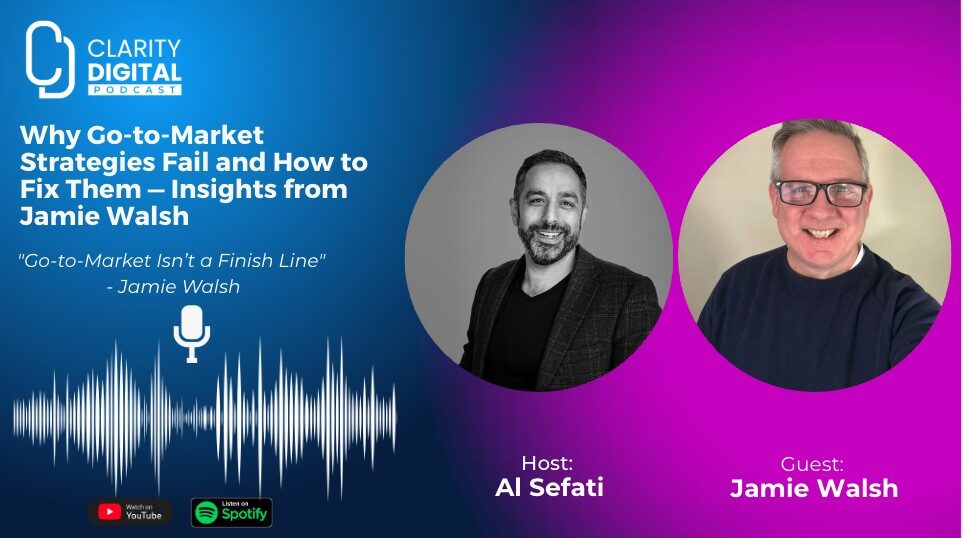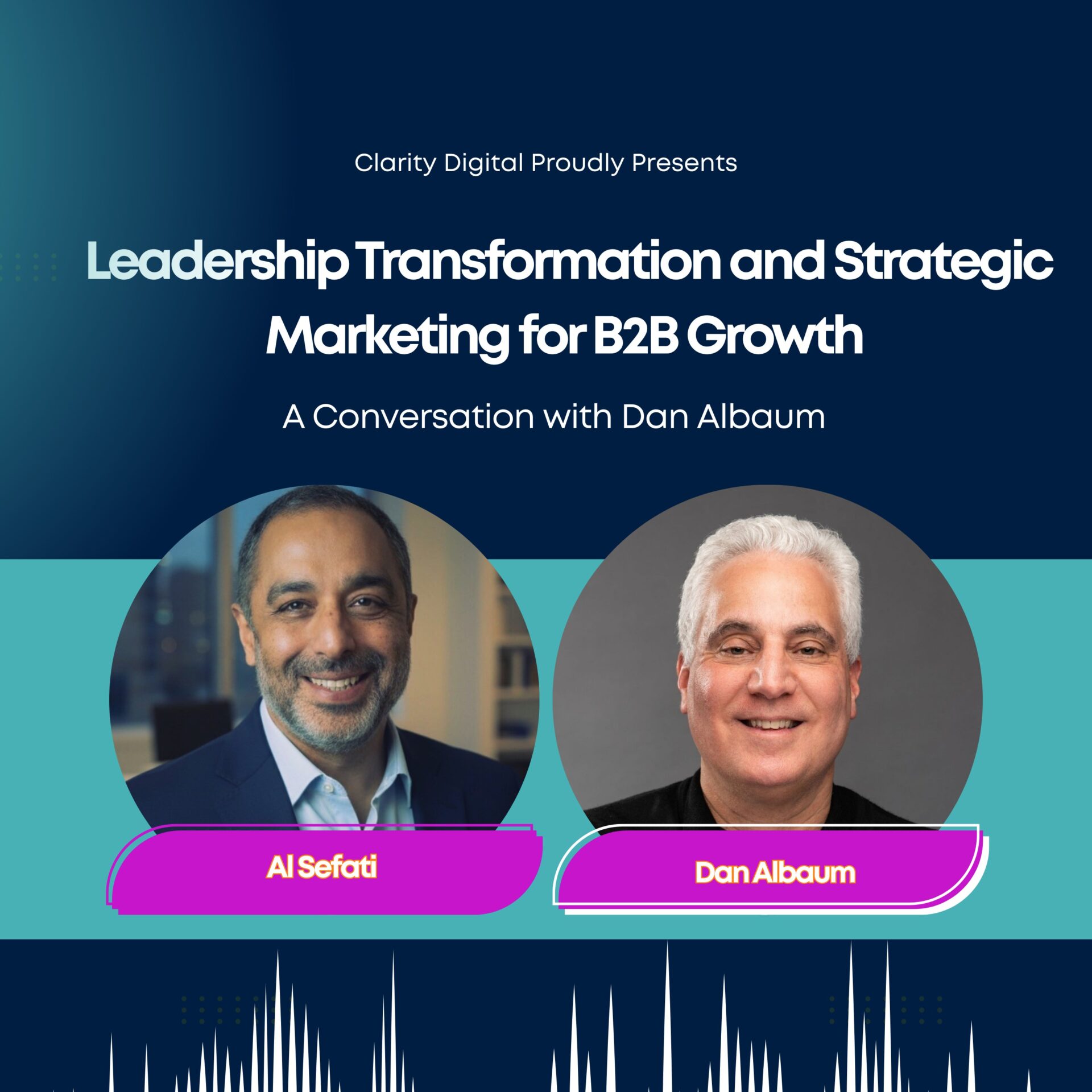“Go-to-Market Isn’t a Finish Line” – Jamie Walsh
Welcome to another episode of Clarity Digital Pod. On this episode, I sit down with Jamie Walsh — a seasoned product marketing and GTM strategist who has helped SaaS companies scale from Series B to D. We dig into why startups often get product-market fit wrong, how to avoid go-to-market pitfalls, and the role AI and data play in creating scalable growth strategies. If you’re a founder, CMO, or B2B marketer looking to tighten your GTM playbook, this episode is packed with practical insights.
Startups often chase growth without laying the right strategic foundation. In this episode of the Clarity Digital Pod, I had a thoughtful conversation with Jamie Walsh, a seasoned product marketing and go-to-market (GTM) leader with over two decades of experience. Jamie has worked across the SaaS ecosystem, from GRC platforms at Nasdaq to startups in Series B to D stage. We dug deep into why so many companies get product-market fit wrong, the hidden landmines in GTM strategies, and how to build scalable processes that don’t fall apart when it’s time to grow.
If you’re a founder, CMO, or part of a growing startup team, this episode is your blueprint to understanding the role of product marketing and how to diagnose, build, and scale a go-to-market strategy that actually delivers.
The Role of Product Marketing in GTM Success
From my experience as a digital marketer, I’ve seen too many startups overlook product marketing until it’s too late. Jamie and I agreed that when companies invest early in this discipline, their GTM efforts become far more structured and scalable.
Jamie’s background is unique. Starting in GRC as a practitioner and consultant, he eventually transitioned into customer success, account management, and then product management, where he truly found his stride in product marketing. His work has spanned everything from startup advisory to full-blown corporate GTM planning.
According to Jamie, product-market fit isn’t the end goal—it’s just the beginning. “It’s like getting into a good college,” he said. “You’ve proven you’re capable, but now you have to perform at scale.”
Why Product-Market Fit Isn’t Enough
One of the most valuable insights Jamie shared is that many founders mistake early traction for sustainable fit. Startups often cling to their original product hypothesis, only to later find out—through actual data and buyer behavior—that their audience is someone entirely different.
Founders typically validate an idea with a handful of customers, but scaling that into a real business requires far more than intuition. AI can be a great tool here, Jamie noted, especially when it comes to clustering customer signals and surfacing patterns you might miss.
The key takeaway: Product-market fit is only the first gate. True GTM fit comes next—and that’s where the hard work begins.
Building the Right Infrastructure
A common pain point we both touched on was how startups approach scaling. Often, the systems and tactics that worked to land those first ten customers don’t translate when aiming for 100 or 1,000. At that point, infrastructure becomes everything.
Jamie emphasized that determining what infrastructure to build—and when—must be a team effort. He referenced the “four horses” of GTM alignment:
- Product Management
- Marketing
- Sales
- Customer Success
Without alignment between these four groups, things break down fast. In SaaS, especially enterprise SaaS, that lack of coordination leads to churn, missed revenue, and internal conflict.
“Startups don’t fail because of bad ideas,” Jamie said. “They fail because of poor execution and lack of alignment.”
Diagnosing Bottlenecks
Jamie shared a framework for identifying hidden bottlenecks. Step one is always diagnosis. If you can’t accurately pinpoint what’s broken, adding fuel to the fire only makes things worse.
Misalignment in messaging is a common culprit. Sometimes you’re just talking to the wrong audience—or using the wrong language. Jamie advised that messaging should evolve every 12 to 18 months, especially as your product matures and your buyer persona shifts.
For example, you might think you’re building for financial services, but actual traction is coming from transportation or manufacturing. That’s where data comes in. “Go where the money’s at,” Jamie advised. “Don’t waste time forcing it in the wrong vertical.”
Understanding the Buying Committee
Jamie’s GTM approach involves mapping out personas across the buying committee. He typically builds playbooks for four key personas per campaign. Each one has different needs: practitioners want technical details, while execs care about ROI and business impact.
He also makes room for “influencers” like consultants and agencies—folks like us—who may not be the buyers, but whose opinions heavily sway decisions. Many startups overlook these players in their GTM strategies, which Jamie believes is a costly mistake.
“They might not sign the check,” he said, “but they can absolutely stop the deal—or close it faster.”
The AI Factor in Go-To-Market
When asked how much he uses AI, Jamie’s answer was simple: “Not enough.”
He uses a range of tools like ChatGPT, AirOps, Gamma, and SparkToro. AI helps him process call data, competitive intelligence, and CRM exports to speed up everything from positioning to content generation.
He’s even built his own custom GPTs to streamline things like messaging, SDR scripts, and pitch decks. One interesting use case: He dictates an outline, runs it through ChatGPT, and then uses Gamma to auto-generate a presentation—saving hours of time.
“AI is a force multiplier,” Jamie said. “But you still need the strategy to guide it.”
Tools Jamie Recommends
Here’s a snapshot of the tools Jamie uses in his GTM workflow:
- ChatGPT – For ideation, messaging frameworks, data synthesis
- Gamma – For fast presentation and landing page creation
- SparkToro – Audience research and channel insights
- AirOps – Structured content creation
- Salesforce (exports) – CRM insights and segmentation
- Leonardo, Runway, Midjourney – For image and video generation
- Lovable – No-code tooling for lead magnets and web assets
He also emphasized the importance of proper prompting. “Learning how to prompt well changed the game,” he said, echoing my own experience taking recent Coursera courses on the topic.
When Startups Pivot or Get Acquired
What happens when your startup gets acquired or merges with another? Jamie has lived through it. From Nasdaq to SAI Global and beyond, he’s had to align GTM efforts across multiple brands, cultures, and messaging strategies.
His advice: fall back on the data. Use it to tell a compelling story when leadership’s direction doesn’t align with what’s working in the field.
“You can’t argue with real numbers,” he said. “It’s the best way to influence up.”
Fractional Support That Works
Jamie runs GTM Factories, a consultancy offering structured, playbook-driven GTM services for early-stage and growth startups. His flagship offering is called “30 Days to Clarity,” which gives companies deep insight into their true ICP, what’s working, and what needs to be rethought.
He works hand-in-hand with SDRs, product teams, and agencies (like us) to create messaging, sales assets, and positioning frameworks that are both strategic and tactical.
What sets Jamie apart is his ability to move fast without cutting corners. That’s something every startup needs when racing toward the next round of funding.
Final Thoughts
Jamie summed it up perfectly: “A go-to-market strategy is complete—but never finished.”
It’s a living, breathing system that should evolve with your product, market, and customer behavior. With the right alignment, tools, and strategic mind behind it, startups can move from scrappy survival to scalable growth.
We wrapped up the conversation with a few personal notes: Jamie’s a Pittsburgh sports fan, a father of two teenage daughters, and a former software dev who still gets excited about new tech.
You can find more about Jamie and his services at GTMFactories.com and you can also connect with him on LinkedIn.




